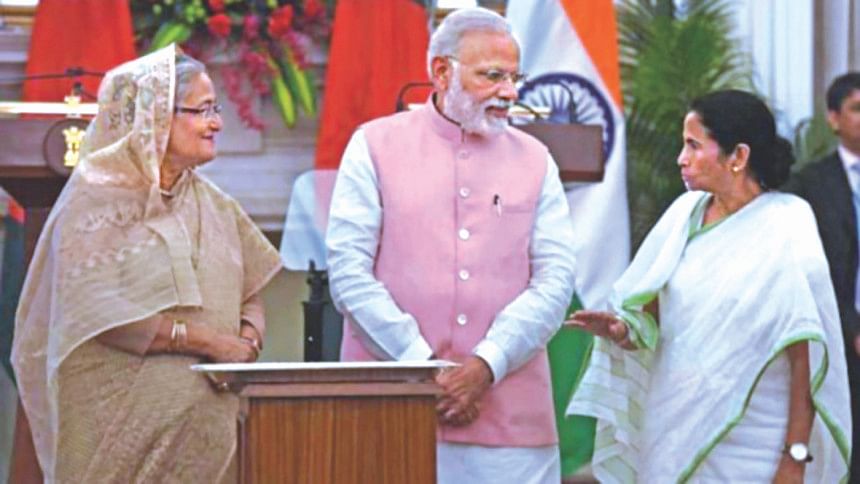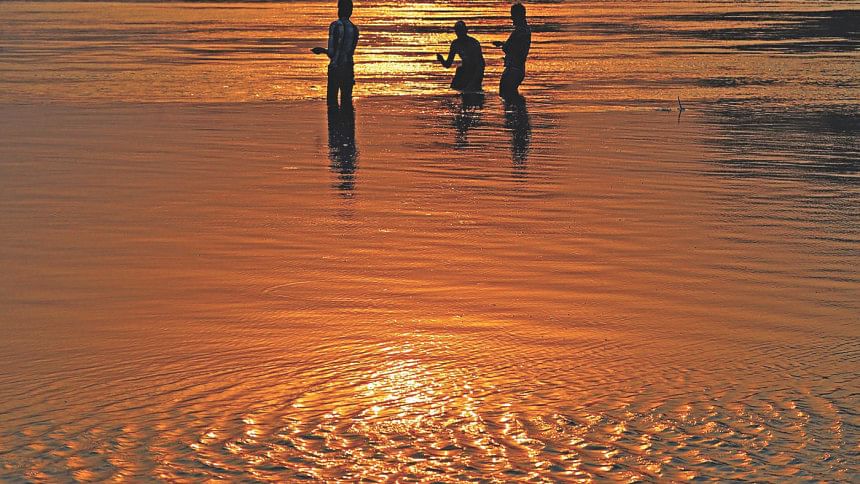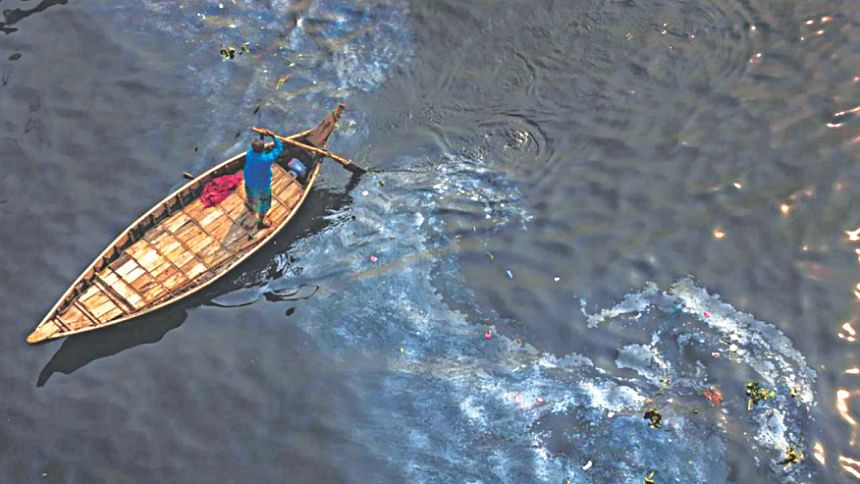The crying need for collaborative management of our waterbodies

At the very core of our entire ecosystem is the location and availability of fresh water on which lives and human livelihood are fundamentally dependent. One school of thought envisages future wars being fought over steadily depleting water resources, required by humans, other species and vegetation that sustain both. To prevent this situation from deteriorating further to the point that it could become an existential threat for man's survival in whatever geo-space he inhabits, we need to engage in collaborative management of the shared ecological space and resources, particularly fresh water resources that are critically taxed and in a state of alarming depletion today.
The South Asian region has over 22 percent of global population but under 10 percent of global freshwater resources. Being blessed with some of the world's mightiest rivers, the region as a whole possesses fairly adequate, if not abundant, waters which are very poorly managed. Steady growth of population in South Asia has made this region one of the most densely populated globally, with very large numbers subsisting on marginal land. South Asia's average percentage of population between ages 15-59 in 2015 was 60.75; in 2050, this average is projected to be 60.88 (ECOSOC, 2015). The trend of population growth, unless significantly reduced, will surely add pressure on the already tight water and food supplies. For a deltaic region like Bangladesh, which is the natural drainage for most of the Eastern Himalayan rivers, a double-whammy effect is already in progress. The sheer increase in population and the cumulative effects of glacier melts in the Himalayas and depleted groundwater aquifers is already significantly and adversely impacting availability of fresh water supplies.
The Himalayas (Eastern and Western) are drained by 19 major rivers: The Indus (Western Himalayan) and Brahmaputra (Eastern Himalayan) are the largest, each with catchment basin of 259,000 square kms. The Brahmaputra system comprises three sub-basins—Teesta, Raidak and Manas: draining 182,000 square kms. The Ganges River is the longest in South Asia, stretching 2,529 kilometres from its highest source to its discharge point into the Bay of Bengal in Bangladesh. Its basin comprises about 1,087,795 square kms. The Himalayan glaciers (some 15,000) play an important role in draining higher altitudes of the Himalayas and feeding the Himalayan rivers. The Chemayungdung (Jima Yangzong)/Angsi Glacier, near Mt Kailash, in southwest Tibet is source of the Brahmaputra, known in China as the Tsangpo, flowing through Bhutan and India into Bangladesh where it becomes the Jamuna. The Ganges rises in the western Himalayas in Uttarakhand state of India, with major tributaries from Nepal (Kosi and Gandaki). It is fed by the Gangotri Glacier at Gomukh in India, the Bhagirathi River and the Alaknanda River (originating from the Nanda Devi mountain). The Ganges basin, including the delta but excluding the Brahmaputra and Meghna basins, covers parts of four countries: Bangladesh, China, Nepal and eleven states of India—namely (Himachal Pradesh, Uttarakhand, Uttar Pradesh, Madhya Pradesh, Chhattisgarh, Bihar, Jharkhand, Punjab, Haryana, Rajasthan West Bengal and the Union Territory of Delhi; with 80 percent of it in India, 13 percent in Nepal, 4 percent in Bangladesh (where it is known as the Padma), and 3 percent in China.

Most glaciers are in retreat. Himalayan glaciers have shrunk from 500,000 square kms coverage to 160,000 square kms. Recent temperature rise in Tibetan Plateau was twice the global average. As a result of increasing global warming and anthropogenic activities, recent ICIMOD findings reveal that the Glaciers that feed Brahmaputra are likely to reduce by 20-25 percent by 2050.
Fast melting glaciers have created and will continue to create numerous glacial lakes at their base that will be subject to bursting banks (like the Kedarnath tragedy in 2013). About 60 percent of Brahmaputra waters are from rains while the remaining are derived from glaciers, base flow and snow melt. Initially, river water run-off is likely to increase from 0-13 percent because of fast melting glaciers, lulling us into misplaced complacency. We may expect erratic behaviour with sudden increases and sudden decreases, with unexpected floods and droughts being likely. Some of the dangers to total water received downstream in Bangladesh along the Brahmaputra are: the reported proposed Chinese diversion of 200 billion cbms of waters from Yarlung-Xangpo to the Yellow River, and the progressive melting of Himalayan glaciers as a result of climate change, which will adversely impact the amount of water levels and flow force in the Brahmaputra. As the Brahmaputra river dries up, along with other rivers critical to the survival of peoples in South Asia, gross per capita water availability may decline by one-third by 2050. Today, the Brahmaputra River is navigable for only a few months of the year. On account of not tending to the river, continuously resulting in much of the heavy silt it carries being deposited on and raising its bed, its expanse has spread across the land widening its girth but sharply reducing navigable depth as well as decreasing overall flow force. But this was not always so.
Rivers will likely eventually become seasonal, as a result of which the line of equilibrium will be broken between sweet and salt waters; creeping salinity inland from the Bay of Bengal will change the PH factors of the soil; keystone species will be wiped out; traditional agricultural patterns will be disrupted; and massive Internal displacements will be triggered. Internal displacements do not remain internalised but lead to intra-state and inter-state tensions/conflicts. According to ICIMOD researcher Agrawal: "The current data indicates more flood risks in the future. If the Brahmaputra is not managed in Tibet, it will affect India and Bangladesh more." Notably, over 73 percent of the Brahmaputra River watershed's original forest is gone. The remaining forestry is disappearing at 10 percent per year. Currently only 4 percent of the forest land is in protected areas.
We must not forget the inextricable nexus that exists between freshwater conservation and management, food self-sufficiency, economic development, political stability and societal wellbeing. Tighter water supplies will inevitably result in tighter food supply (despite increased productivity/acre). We may also brace ourselves for aggravated energy crunch—despite multi-source augmentation, imperatives of demand will exceed pace of augmentation. There will be limited job markets despite increased development and growth. India, with its 1.3 billion population, needs to create 10 million jobs a year; Bangladesh, with 165 million, needs to create 1.1 million jobs annually. A 2 degree C increase in mean air temperature could decrease rain-fed rice yields by 5-12 percent in China. Under one scenario, net cereal production in South Asian countries is projected to decline by 4 to 10 percent by the end of this century. In Bangladesh, production of rice may fall by just under 10 percent and wheat by a third by the year 2050. The situation will be further aggravated by the major rivers, the Brahmaputra-Jamuna, the Ganges, the Meghna and the Padma, swallowing thousands of hectares of arable land on both sides of their banks every year. Between 1970s and early 1990s, mean annual erosion is said to have been approximately 3,300 hectares along both banks of one river alone, the Jamuna
According to IPCC projection, "sea level rise could flood the residence of millions of people living in the low-lying areas of South, Southeast and East Asia such as in Vietnam, Bangladesh, India and China". The Ganges- Brahmaputra- Meghna Basin sub-region in Bangladesh could well be a disaster waiting to happen, with climate change and global warming effects triggering larger regional instability and insecurity, with wider implications. The densely crammed, substantially large populations will have to cope with widespread poverty and under-development, buffeted by very frequent natural and environmental disasters, afflicted by festering insurgencies and extremist militant movements. Rising sea levels will also devour coastal lands and submerging islands. According to most conservative scenario, by the end of 21st century, sea level will be about 40 cm higher than today. If the Bay of Bengal rises by three feet by the turn of the century, it will swallow a fifth of Bangladesh. We should expect changes in the coastal morphology with fallout inland.
Rivers are formidable forces of nature and cannot be tamed; nor can they be trained in parcels. The entire length of the river must be addressed holistically and tamed simultaneously, employing manpower along the entire course of the river, from the headwaters to the mouth. This was how China trained its own "river of sorrow" (the Huang He or Yellow River). The Brahmaputra-Ganges- Meghna Basin countries would have to adopt a similar approach, but they must first necessarily develop a willingness to cooperate and collaborate on jointly managing these Commons. Unfortunately, with the Partitioning of India in 1947, along with land, even water (and skies) were also partitioned. The ecosphere and hydrosphere cannot be partitioned. It is worth remembering that the northeast region of India and Bangladesh, as indeed Bhutan and Nepal as well, were always geomorphologically landlocked, but historically always water-linked through their shared rivers being connected and through coastal connectivity. The Brahmaputra, Ganges and Meghna rivers were historically important in connecting and integrating peoples and economies. River connectivity had existed historically, until severed in 1965. This severance was at the root of many, if not all subsequent problems. Restoring river connectivity is the most important entry point for strengthening dynamics of re-integrating the severed region economically. River connectivity has natural advantage over land connectivity (the latter is very difficult to maintain in terrain largely governed by waters!). Significantly, our British Colonial masters had understood this only too well. The great wealth of the Bengal Presidency that they governed provided Imperial Britain over a third of its total colonial wealth through extraction. Even earlier, during Moghul Era, Bengal alone is said to have contributed over 40 percent of global GDP. In my view, the key to this was the integrated water connectivity network that defined the region's prosperity, rich in food grains and cash crops. The British augmented their extraction capacity by putting in place a superbly efficient railways system and a string of coastal seaports girdling the jewel in the crown that their colonised sub-continent was—stretching from Karachi in the west, through Bombay, Madras, Vizag/Waltair, Calcutta (and Narayanganj), Chittagong, via the Burmese and Malayan coasts to Singapore. They well understood even then the benefits of water connectivity. It is fuel efficient, cost effective, and environment friendly. One horsepower can carry 4,000 kg load on water, 500 kg by rail and 150 kg by road, while one litre fuel can move 105 ton/km on water (IWT), 85 tons/km by rail and 24 tons/km (WB). Environmentally, water vessels emit 32-36g CO2/ton-km vs roads vehicles range 51-91g CO2/ton-km.
In the EU and elsewhere, over 40 percent of total freight is transported across waters; in India it is only 3.5 percent; in Bangladesh, even less. Reviving river connectivity will be the gateway to a host of other activities, all labour intensive and therefore generating huge employment. Upstream and downstream economic activities will be revived, water conservation will be hugely enhanced, land erosion will be significantly reduced, and land usage better optimised for better planned agriculture. Tens of millions of new jobs will be created, directly benefiting the people of the river—the millions that inhabit along the shores of these mighty rivers. Along with training, expansion of existing irrigation channels along these rivers could be undertaken (that would also serve as overflow drainage channels during high season floods). Dying rivers could be revived and the ecology resuscitated.
For that to happen, current efforts at sub-regional cooperation need to be sustained and encouraged. Its momentum needs to gather more speed, but all need to eschew reviving and reasserting populist neo-nationalism along identity lines.
Bangladesh finds itself in an extremely vulnerable situation in respect of water security, despite being a land of rivers, with three river basins, over a hundred rivers, including four major rivers, of which 54 rivers are shared with India, its immediate upper riparian. A partially executed bilateral treaty exists on only one of the shared rivers (the Ganges), while an agreed draft on another, the Teesta, remains frozen in a state of suspended animation. Taking a river-by-river approach would leave Bangladesh very vulnerable to the vagaries of nature and the unpredictability of geopolitics. The narrative of sharing, furthermore, is evocative of the partitioning of waters which leads into the realm of contestation. In fact, most of the problems contributing to this situation of increasing water distress may be squarely attributed to "The Partition Syndrome" of 1947. At that point of time, when the old Colonial order was disintegrating, it was replaced by a new post-Colonial neo-Westphalian "disorder". New states were formed from a recently gained sense of separate identities that had lain latent and somnolent for millennia, but had been prodded awake by the colonial policy of "divide and rule". They came into existence from a partitioning of the geographical space into three segments. While segmenting land and territories on terra firma is entirely feasible and achievable, what was forgotten in the heat of the highly emotionally charged moment then was that the principles of partitioning land cannot be applied to the hydrosphere, atmosphere and ecosphere. So, the rivers that essentially had flown seamlessly from the headwaters to the mouth since their formation were overnight conceived as "belonging" within the confines of the new national (and sub-national) boundaries drawn on the map. In my view, this fallacious thinking was also reflected in the formulation of the Constitution of the new Indian Union, in which sovereignty of the rivers were accorded to the respective states of the Union through which those rivers traversed. This is at the heart of the myriad problems of water sharing that India has struggled with over almost all its rivers, whether within its domestic sphere or with the new transnational configuration of the rivers. The bitter squabbling between states over their respective share of rivers defied all mediation by several river commissions within India. The state of mind of the Partition Syndrome also governed the Indus River Treaty between India and Pakistan, brokered by the World Bank in 1952—it essentially "partitioned" a mighty and large river basin, holistically comprising six rivers, by allocating three each to the two antagonists fighting over the one bride.

The conditions described above pose several challenges today for the entire region, deliberately neglected for long and hostage to politics of fragmentation and contestation between nations and governments trumping common sense. Governments overall must now cater to far more complex ecological and environmental security, food security, water security, energy security, employment security, and health security. Additionally, governments also must prepare for unexpected disasters (wildcard events) from natural phenomena or threat of disease pandemics. Ensuring water security and integrity is perhaps the most important—water being vital for agriculture, industrial use, power generation, fisheries, human consumption, health and sanitation—but addressing this will also pose formidable challenges. Towards this end, all governments now really have no alternative but to collectively address and treat rivers as Commons. They must shift the narrative away from "sharing" (or dividing the spoils) to managing, collectively and collaboratively, and putting in place an authoritative regional mechanism for meeting these challenges and effectively governing these commons. Our waters are, essentially, at the very heart of our common eco-system that we so heartlessly sought to carve into finite "nationally or sub-nationally owned" segments. South Asians must now put in place a viable governance structure to reasonably manage their ecology and environment.
The computing tools of science in today's digital age that are now available should make it easier for governments to collaborate across borders, domestic or regional. The science of Geographic Information Systems (GIS) is now well developed and an important tool that can help us all better manage our precious, and dwindling, water resources. GIS can be used to help us, with remote sensing tools, to assess the extent of availability and state of health of groundwater resources that have alarmingly decreased or become contaminated through gross and thoughtless over-exploitation. With the use of GIS, we should be able to determine which aquifers are over-taxed or endangered, and put in place regulations for calibrated use, better management and preservation, and ensuring good water quality. GIS can also be used for better watershed and flood management. Remote sensing and use of aerial photography and satellite imaging will enable us to rapidly assess large geographical areas, as well as subsets, for detailed analysis of turbidity and depth. Remote sensing also helps in mapping and monitoring flood plains and making flood assessment, monitoring changes in stream channels and flows. They will better assist us in terrain and flow modelling as well as better monitoring debris flow—an increasingly critical aspect of today's debris-creating social and industrial culture. It will also enable us to observe the effects of water inundation and force flows on existing infrastructure (roads, dykes, culverts) and determine the state of their safety. Using GPS as a force multiplier will help us to better understanding and evaluating the situation. Very importantly, it will help us better fathom the progress of cumulative siltation that takes place continuously in our "young" rivers, enabling us to plan corrective or mitigating measures. These digital tools will also help to better understand the causes for the formation of the relatively recently discovered "dead zone" that has developed and stretches across some 60,000 square kms in the Bay of Bengal—posing a catastrophic danger to our precious marine resources, and to monitor the state of health (or otherwise) of our mangrove forests in the Bay of Bengal. With these digital tools, we should be able to survey, enumerate and map the glacial lakes that are vulnerable to their natural dams bursting, not only causing catastrophic harm to populations living in their vicinity, but also resulting in net loss of freshwater resources that were dammed in these natural storages. But these are all exercises or activities that essentially require cooperative mindsets and collaborative governance.
A decade ago, in 2010, participating in a futures exercise contemplating what South Asia's response would be to the complex non-traditional scenario likely to buffet the region in 2025 (extrapolating from then existing and known facts and situation on the ground), threatening gravely the delicate freshwater scenario, I had advocated the formation of a comprehensive, multi-bodied architecture of cooperative mechanisms, (particularly one governing the management, preservation and use of fresh water) that South Asians would have the common sense to have moved towards, chastened by an angered Mother Nature that needed urgent pacification. Today, I repeat that call, with a greater sense of urgency than ever felt before, for collective consideration by all South Asians to come together.
Tariq Karim is a retired Ambassador and currently Senior Fellow at the Independent University, Bangladesh.

 For all latest news, follow The Daily Star's Google News channel.
For all latest news, follow The Daily Star's Google News channel. 



Comments